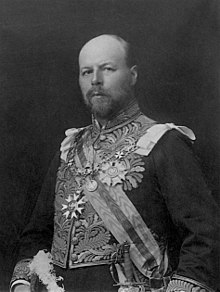Hallam Tennyson, 2nd Baron Tennyson
Sir Thomas Buxton | |
|---|---|
| Succeeded by | Sir George Le Hunte |
| Member of the House of Lords Lord Temporal | |
| In office 6 October 1892 – 2 December 1928 Hereditary Peerage | |
| Preceded by | Alfred Tennyson, 1st Baron Tennyson |
| Succeeded by | Lionel Tennyson, 3rd Baron Tennyson |
| Personal details | |
| Born | 11 August 1852 Twickenham, Middlesex, England |
| Died | 2 December 1928 (aged 76) Freshwater, Isle of Wight, England |
| Spouses | Audrey Boyle
(m. 1884; died 1916)Mary Prinsep (m. 1918) |
| Children |
|
| Parent(s) | Emily Sellwood |
| Alma mater | |
Hallam Tennyson, 2nd Baron Tennyson,
Tennyson was born in
Early life

Hallam Tennyson was born in Chapel House, a house his father was renting in Twickenham, Middlesex. His parents were Emily (née Sellwood) and Alfred Tennyson. He was named after his father's deceased friend Arthur Hallam. Tennyson's early childhood was spent at Farringford House on the Isle of Wight, which his father began renting in 1853 and bought in 1856. He was educated at Marlborough College and Trinity College, Cambridge.[1] Tennyson's career aspirations ended when his parents' age and ill-health obliged him to leave Cambridge to become their personal secretary. The idea of going into politics was also abandoned.
It was partly for Hallam's benefit that Alfred Tennyson accepted a peerage in 1884, the year Hallam married Audrey Georgiana Florence Boyle (after being disappointed in his love for Mary Gladstone, daughter of William Ewart Gladstone). On his father's death in 1892, he inherited the title Baron Tennyson, and also the role of official biographer. His Tennyson: A Memoir was published in 1897.
Governor of South Australia
Like his father, Tennyson was an ardent imperialist, and in 1883 he had become a council member of the
Governor-General of Australia

Tennyson was the senior state governor at the time of Hopetoun's announcement, and thus became
The new Governor-General was popular and got on with Australians far better than his predecessor had done. But problems arose through the ambiguity of his position. The Prime Minister, Alfred Deakin, insisted that the Governor-General's official secretary must be appointed and paid by the Australian government. The British government objected (privately) because this would mean that the Governor-General could not carry out what was seen in London as his broader role in supervising the Australian government. Tennyson shared this view.
As a result, relations between Deakin and Tennyson grew tense. Deakin correctly suspected that Tennyson was reporting on him to London and trying to interfere on matters of policy, such as the naval agreement between Britain and Australia. For this reason Deakin did not encourage Tennyson to seek an extension of his one-year term. None of this was known to the public and Tennyson left Australia in January 1904 to universal expressions of approval.
Retirement and death

Tennyson spent the rest of his life at Farringford, serving as deputy
Tennyson bequeathed many of his father's notebooks to Trinity College in 1924.[1]
He had three sons by his first wife:
- Lionel Hallam Tennyson, 3rd Baron Tennyson (7 November 1889 – 6 June 1951), married Hon. Clare Tennant, daughter of Edward Tennant, 1st Baron Glenconner; remarried to Carroll Donner (née Elting)
- Sub-Lieutenant Hon. Harold Courtenay Tennyson (1896–1916), killed in action during World War I
- Captain Hon. Alfred Aubrey Tennyson (1891–1918), killed in action during World War I
Tennyson died at Farringford on 2 December 1928.
Commemoration
- A large oil portrait of Tennyson hangs in Admiralty House, Kirribilli.
- Tennyson's coat of arms is painted in the entry foyer of Government House, Sydney.
Arms

|
|
References
- ^ a b "Tennyson, Hallam (TNY871H)". A Cambridge Alumni Database. University of Cambridge.
- ^ "No. 27502". The London Gazette. 9 December 1902. p. 8509.
- ^ 'Christabel,' Mary Emily 'May' Prinsep, Julia Margaret Cameron, albumen print on gold-edged cabinet, 1866, Photographs Collection, National Portrait Gallery, npg.org.uk
- ^ Debrett's peerage, baronetage, knightage, and companionage. London : Dean & Son. 1903. p. 798, TENNYSON, BARON. (Tennyson.). Retrieved 26 June 2022.
 This article incorporates text from this source, which is in the public domain.
This article incorporates text from this source, which is in the public domain.
- ^ Burke, Bernard; Burke, Ashworth P. (1915). A Genealogical and Heraldic History of the Peerage and Baronetage, the Privy Council, Knightage and Companionage (77th ed.). London : Harrison & Sons. pp. 1945–1946, TENNYSON. Retrieved 26 June 2022.
 This article incorporates text from this source, which is in the public domain.
This article incorporates text from this source, which is in the public domain.
- Serle, Percival (1949). "Tennyson, Hallam". Dictionary of Australian Biography. Sydney: Angus & Robertson.





